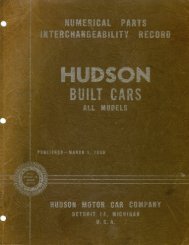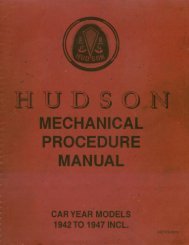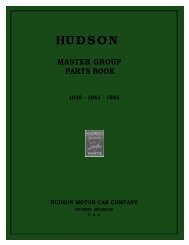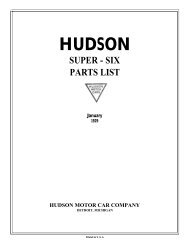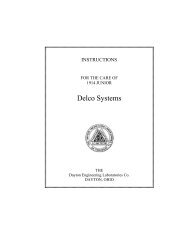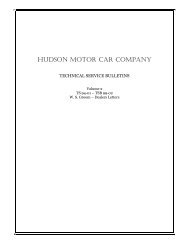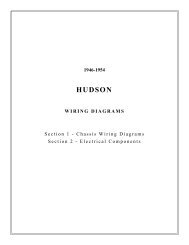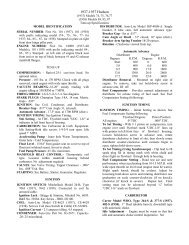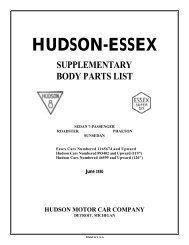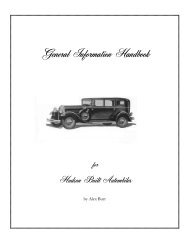1948-1952 Shop Service Manual - - Hudson-Essex-Terraplane Club
1948-1952 Shop Service Manual - - Hudson-Essex-Terraplane Club
1948-1952 Shop Service Manual - - Hudson-Essex-Terraplane Club
Create successful ePaper yourself
Turn your PDF publications into a flip-book with our unique Google optimized e-Paper software.
ELECTRICAL SYSTEM 6 - 19<br />
3. Run engine at approximately 2000 RPM.<br />
4. Turn resistor knob in until ammeter reads 10 to 15 amperes<br />
and then check the voltmeter reading which should be 7.2 to<br />
7.5 volts.<br />
NOTE: If car is out of warranty the voltage regulator can<br />
be set by bending the spring hanger to get this necessary<br />
reading. The unit must be final-checked with the voltage<br />
regulator cap in place as generally it will change the<br />
reading from .1 to .2 of a volt and must be compensated<br />
for in making this adjustment.<br />
5. Stop engine, disconnect battery negative terminal and<br />
then proceed to remove the tester leads from the voltage<br />
regulator and Install the wires back onto the "B" terminal<br />
of the regulator.<br />
6. Install the voltage regulator cover.<br />
VOLTAGE REGULATOR ADJUSTMENT:<br />
1. To adjust operating voltage remove cover and change the<br />
armature spring tension by bending the lower spring<br />
hanger. Increasing the tension raises the operating voltage;<br />
decreasing the tension lowers it.<br />
2. Replace cover and recheck.<br />
3. After each adjustment stop the engine and restart it.<br />
Bring engine up to speed and adjust current to 10 to 15<br />
amperes before taking a reading.<br />
CURRENT REGULATOR CHECK:<br />
1. Disconnect the battery wire at the voltage regulator "B"<br />
terminal and connect the test ammeter between the voltage<br />
regula-<br />
regulator "B" terminal and the wire disconnected, Figure 16.<br />
2. Connect a starter battery tester directly across the battery<br />
and set load to 50 amperes, or use the equivalent in seal<br />
beam lamps.<br />
3. Run engine to approximately 2000 RPM; amperage<br />
reading should be 40 amperes. If it is not within a tolerance<br />
of one to two amperes of this reading, the regulator<br />
should be removed and taken to an authorized Auto-Lite<br />
dealer for replacement.<br />
NOTE: If car is out of warranty, remove the voltage cover<br />
and adjust the current regulator spring hanger to the<br />
necessary 40 ampere output. To prevent operation of the<br />
voltage regulator unit while making this adjustment,<br />
place a jumper across the voltage regulator points. For<br />
final checking, the regulator cover must be in place on<br />
regulator.<br />
CAUTION: Momentarily touch the negative battery cable<br />
to battery negative post to determine that there is no<br />
sparking between the battery negative post and cable<br />
terminal, then connect negative cable.<br />
CURRENT REGULATOR ADJUSTMENT:<br />
1. To adjust operating amperage, remove cover and change<br />
armature spring tension by bending the lower spring<br />
hanger. Increasing tension raises the operating amperage;<br />
decreasing the tension lowers it.<br />
2. Replace cover and recheck. Stop engine and restart after<br />
each adjustment. Take readings with cover in place.<br />
REGULATOR CONTACT POINTS:<br />
FIGURE 16<br />
In normal use the contact points on all three regulator<br />
units will become grayed. If the contacts are burned,<br />
dirty, or rough, the points should be filed just enough to<br />
secure a smooth surface. File parallel with and lengthwise<br />
to the armature. Clean the points with a piece of<br />
linen or lintless bond tape dipped in carbon tetrachloride<br />
and follow with dry tape. Use clean tape for each<br />
set of contacts.



